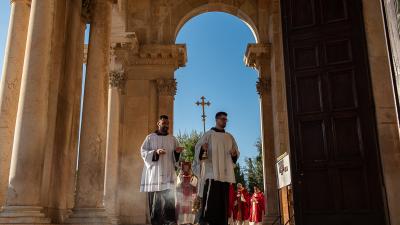
Jerusalem was glistening from atop the Mount of Olives, while the strong sun warmed the air and the soil. In that very place, a crowd of friars and pilgrims gathered on May 24 in front of the Chapel of the Ascension and the tents surrounding the Holy Place. The “sacristy” tent, the “refectory” tent, the “superiors’”tent, and finally the “dormitory” tent were all very useful in the warm weather of the early afternoon hours, when the heads of the Christian churches in Jerusalem made their solemn entry. The various denominations celebrated the solemnity of the Lord’s Ascension all on the same day, because it fell on the same date, as did Easter.
The octagonal chapel of the Ascension was built in the Crusader period and it is currently on a Muslim property. Christians are allowed to access it for this celebration. There is a stone that is still present that, according to tradition, would bring have born the feet of Jesus as he was ascending to heaven.
The Latins were the first to enter the Holy Place, followed by the Armenians, the Copts, the Syriacs, and the Greek Orthodox. Outside the chapel, a festive atmosphere characterized the whole day, in the name of prayer, but also of fraternal communion. In the tents pitched on the small stone altars, which remain uncovered throughout the year, Franciscans, Armenians, Syriacs, Copts and Greeks met--not just priests but lay people as well. A Coptic Christian student expressed her joy: “It is great to be here to celebrate this feast, and to see what is happening around here, to [be able to] pray together.”
After the entry of Custodial Vicar, Fr. Dobromir Jasztal, the Franciscans continued by praying Vespers and the Compline and by celebrating the vigil. With Latin songs and the warm sun of the early afternoon, the solemn procession made its way around the Edicule of the Ascension three times. As if they were recreating what happens at the Holy Sepulcher, from their tents placed alongside the Edicule, the members of other churches stood still still as they watched the Franciscans pass before their eyes.
At 11 a.m., the friars gathered again for the Vigil of the Ascension. It was a night prayer, like that of the disciples on the Mount of Olives the night that Jesus was captured. Crammed inside the little chapel, they sang songs and proclaimed the readings also for the faithful who, not having found a place to stand, followed the liturgy from outside. From midnight on, the masses succeeded each other, one after the other in different languages. There was a great influx of faithful for the Arabic-language masses, for which coach buses arrived full of people in the middle of the night.
It was not yet dawn when the last mass began, in Latin. The sounds of the organ and the word of God broke the silence and welcomed the sun that was slowly rising.
“The Ascension is what connects Easter Sunday to Pentecost,” said Fr. Dobromir Jasztal in his homily. It makes us understand the goal of Jesus’ incarnation, of the Passion, the death and the resurrection. He became man for man to be elevated to glory and communion with God.” The vicar then explained that with the Ascension comes the fulfillment of Emmanuel’s prophecy, already mentioned by Isaiah seven centuries before Christ, which means “God with us.” Emmanuel is also the name with which the angel explains to Joseph the meaning of Mary’s pregnancy. “Emmanuel is the name with which Jesus greets his disciples in this place, saying ‘I am with you’ until the end of the age,” said Fr. Dobromir.
Beatrice Guarrera




